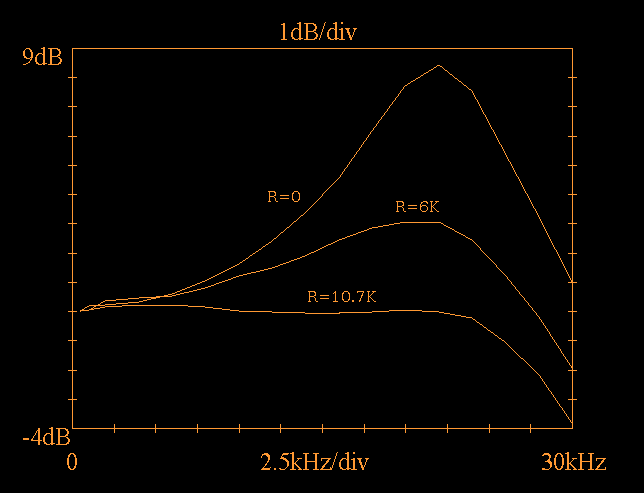For a long time the hybrid electrostatic systems that I made sounded harsh. Some sounds in particular, for example the upper registers of violins, sounded almost unbearably strident. When I measured the response of my ESLs, I observed a rising high end on axis. At first I thought maybe this was a natural property of electrostatics, that they tend to concentrate the high frequencies in the far-field, on-axis response. I tried to correct for this effect in my active crossover circuits, but I was never very successful. Later on I found out that ESLs, or at least ideal ESLs, should be driven with a constant current source rather than a voltage source, as I was doing (see the section on diaphragm material for a discussion of the reasons for this), which might also explain this phenomenon. I was so bothered by this that I finally decided to carry out some investigations to determine the root of the problem. During these investigations I measured the frequency dependence of the signal that was being delivered to the terminals of the electrostatic cells, and I was surprised by what I found. The problem turned out to be with the step-up transformer.
I had read about transformer resonance in Roger Sanders' articles and elsewhere, but somehow it had never before struck me as an important problem that needed to be addressed. I think this is because in the literature the effect is downplayed - it seems to be dismissed as a second-order effect or even as desirable, since it provides a boost of the high frequencies that somehow enhances the listening experience. When I actually did some measurements, however, I was surprised at the magnitude of the effect. The following illustrates how I carried out the measurements:

For the audio source I used a programmable sine wave generator that I was confident would produce constant amplitude sine waves vs. frequency. For the power amplifier I used the actual power amp that I intended to use with my speakers, since amplifiers do not necessarily produce flat output when driven with capacitive loads. The results I present here are for the Hammond 1650E step-up transformer, which as far as I know is still available from Antique Electronic Supply . The capacitor enclosed in a box represents the electrostatic cell, which electrically looks a lot like a capacitor. I put a series resistor R between the output of the step-up transformer and the ESL. I then measured Vesl as a function of frequency, for different values of R. The following shows the results I obtained for the Hammond transformer:

The case for R=0 above is where the ESL is directly connected to the step-up transformer, which is the way that I connected my ESLs for many years. I think it is clear why my speakers sounded harsh! The reason for the high-frequency peak is that the transformer exhibits a leakage inductance at its output which forms a resonant circuit with the ESL capacitance. In a series-resonant LC circuit, the voltage across the individual elements L and C can be much greater than the voltage across the series combination.
Fortunately, there is a simple and effective solution to this problem. By placing a suitable resistor R in series with the ESL, the response at the ESL terminals can be made very nearly flat with frequency. The above figure shows that for the Hammond 1650E transformer and for my ESL, the optimum value for R is about 10.7K Ohms. Unfortunately, the optimum value for R depends on the particular transformer/ESL combination that you use. I also did the same measurements for the Triad S-142A transformer (no longer available), and I found that the optimum resistance for that transformer was about 8.9K Ohms. When I added these series resistances to my speakers, listening tests confirmed that the harshness I had experienced for so long was finally cured.
Before leaving this topic, I should also mention that it may be possible to put the resistor R before the step-up transformer, rather than after it. I would guess that this configuration would produce about the same effect, however I've never tried it so I can't say for sure. Of course the required R value would be much smaller, scaled down by the turns ratio squared of the transformer.
Placing this resistor in series with the ESL (or the step-up transformer) has an added benefit, in addition to leveling out the frequency response. At high frequencies, the ESL presents a low impedance to the driving amplifier. The extra series resistance will help somewhat to relieve the loading of the amplifier on the high frequency end.
Home